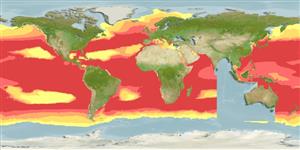Preferred temperature (Ref.
123201): 7.9 - 28.1, mean 23.4 °C (based on 1998 cells).
Phylogenetic diversity index (Ref.
82804): PD
50 = 0.5352 [Uniqueness, from 0.5 = low to 2.0 = high].
Bayesian length-weight: a=0.00263 (0.00112 - 0.00620), b=3.17 (2.96 - 3.38), in cm total length, based on LWR estimates for this (Sub)family-body shape (Ref.
93245).
Niveau trophique (Ref.
69278): 3.5 ±0.4 se; based on size and trophs of closest relatives
Résilience (Ref.
120179): Milieu, temps minimum de doublement de population : 1,4 à 4,4 années (Assuming Fec < 10,000).
Fishing Vulnerability (Ref.
59153): Moderate vulnerability (40 of 100).
Nutrients (Ref.
124155): Calcium = 39.6 [12.5, 119.7] mg/100g; Iron = 1.21 [0.45, 6.66] mg/100g; Protein = 3.95 [0.22, 7.80] %; Omega3 = 0.269 [0.118, 0.593] g/100g; Selenium = 27.7 [6.4, 78.5] μg/100g; VitaminA = 6.37 [2.13, 20.36] μg/100g; Zinc = 0.752 [0.368, 1.431] mg/100g (wet weight);
